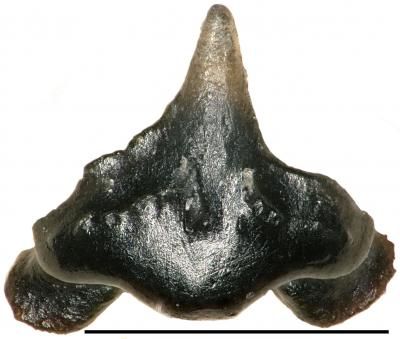New Prehistoric Shark Species Discovered Alongside Sue the T. Rex
The teeth of Galagadon nordquistae were discovered in the rock that once surrounded the famous T. rex skeleton.
/https://tf-cmsv2-smithsonianmag-media.s3.amazonaws.com/filer/76/97/7697608a-bbf0-436d-bced-9994a2499a84/190311_web.jpg)
Dinosaurs tend to dominate our vision of the past. As large and imposing as they were in life, they loom even larger in our imaginations. But much more than just the "terrible lizards" lived and thrived during the Mesozoic era, and some of the creatures that lived alongside the dinosaurs actually bear a striking resemblance to the animals of today.
Sharks, for example, are some of the most successful creatures to ever live. Their fossil record stretches back about 400 million years and includes ancient species both strange and familiar. A new finding adds to the long-lived legacy of these marine predators. Fossil shark teeth were recently discovered alongside the bones of the most famous and complete T. rex skeleton ever found, helping to fill out a more detailed picture of life during the last days of the dinosaurian reign.
The tiny teeth, petrified tidbits about the size of a pinhead, look straight out of an 1980s videogame. They took a circuitous route to discovery, which started with the excavation of the nearly complete Tyrannosaurus known as “Sue” back in 1990. As the tyrannosaur’s bones were removed from the ground, the encasing rock, called matrix, was left around the bones to keep them safe until more detailed prep work could be carried out. Chicago’s Field Museum, where Sue resides today, saved the matrix for future sifting and study. Almost three decades later, those efforts yielded the tiny teeth of a shark that swam upstream in rivers to live in Sue’s neck of the woods.
"This shark lived at the same time as Sue the T. rex, it was part of the same world," said Pete Makovicky, the Field Museum's curator of dinosaurs and one of the authors of a study describing the new species, in a press release. "Most of its body wasn't preserved, because sharks' skeletons are made of cartilage, but we were able to find its tiny fossilized teeth."

North Carolina University paleontologist Terry Gates led the work to characterize the new shark species in the Journal of Paleontology. An appropriate name for the ancient shark was immediately apparent to the researchers. Each of the small, triangular teeth look like the persistent space invaders in the 1981 arcade classic Galaga. Thus, Gates and colleagues named the shark Galagadon nordquistae, with the species name also honoring museum volunteer Karen Nordquist for finding the first fossilized tooth.
"It was so tiny, you could miss it if you weren't looking really carefully," Nordquist said in a press release. "To the naked eye, it just looks like a little bump, you have to have a microscope to get a good view of it."
Based on comparisons with other fossil shark teeth, the team proposes that Galagadon belonged to a major shark family called orectolobiformes, or carpet sharks. DePaul University paleobiologist Kenshu Shimada agrees with this identification. Galagadon, he says, “serves as another example of the diversification of this shark group not only in oceans worldwide, but also in the freshwater systems in the terrestrial environments near the end of the so-called ‘Age of Reptiles.’” While only the teeth of Galagadon are known so far, their shape suggests that the living animal would have looked something like today’s bamboo sharks, a subset of carpet sharks found in the warm waters of the Indo-Pacific.
What has intrigued paleontologists about Galagadon, though, is what the shark can reveal about the world that Sue stomped around in. “The new study, including the recognition of the new species, sheds light on the complex evolutionary history of the freshwater system that existed in North America when T. rex roamed the Earth,” Shimada says.
Even though dinosaurs often dominate the spotlight, it’s often the meeker species that help paleontologists reconstruct what ancient environments were really like. Smaller animals such as frogs, turtles and fish can help narrow down the details of ancient habitats like climate and systems of waterways.
Until now, it seemed that the body of Sue was deposited in a lake that had been created by a nearly-dried-up river. It was thought to be a relatively self-contained habitat. But the presence of a shark species only known in ocean environments indicates that the river was likely connected to the sea, allowing Galagadon and other species to swim inland. Without the shark teeth, paleontologists would have missed this watery connection. Whether Galagadon moved in formation like its video game namesakes, though, will have to wait for future finds.
/https://tf-cmsv2-smithsonianmag-media.s3.amazonaws.com/accounts/headshot/RileyBlack.png)
/https://tf-cmsv2-smithsonianmag-media.s3.amazonaws.com/accounts/headshot/RileyBlack.png)